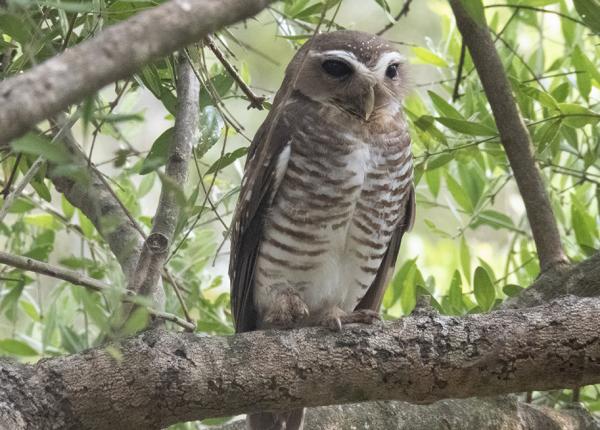Did You Know?
- The White-browed Owl is endemic to Madagascar.
- There is a lot we still don't know about this owl species.
- Some people have reported that this species nests on the ground, but these reports have not been confirmed.
How The Peregrine Fund is Helping
Though The Peregrine Fund doesn't work directly with the Frances's Sparrowhawk, we have a very strong conservation program in Madagascar. Apart from the studies we conduct on several endemic raptors, we work hand in hand with the locals to help foster conservation on the island. Among our three conservation areas, we have assisted communities in planting more than 215,000 saplings to restore forests and establish plantations for food and jobs. We have fostered a professional staff of more than 30 Malagasy people, many with advanced degrees, who contribute scientific knowledge and lead their communities in conservation.
Additionally, our efforts in scientific research, habitat conservation, education, and community development help conserve birds of prey around the world. We also supply literature to researchers from our avian research library, which helps scientists around the world gather and share important information on raptor conservation.
Where They Live
The White-browed Owl is found only in Madagascar, and nowhere else on the planet! Within its island range, it does inhabit a few different habitat types. It lives in deciduous and evergreen forests, wooded savannas, dry thorn scrub, and rocky ravines. Some individuals have also adapted to living and hunting in villages. It makes its home in these habitats from sea-level to about 800 m in elevation
What They Do
With a name like "white-browed owl" it stands to reason that this bird would have white brows, which it does... sort of. Strictly speaking, birds don't have eyebrows in the strictest sense of the word. However, these owls have white lines of feathers above their eyes, that gives them appearance of having white eyebrows! This owl has a smooth, round head and lacks ear tufts.
Like most owls, the White-browed Owl is nocturnal, meaning it is active at night. It spends its days roosting, or resting, in a safe perch.
Why They Need our Help
Though this species is categorized as Least Concern, its population is in decline. And because we know so little about this species and its habits, it could be at greater risk than we know. Even though it is adaptable to living in human-altered and human-occupied habitats, its overall population still likely suffers from habitat loss and degradation.
What They Eat
Very little is known about the White-browed Owl's diet. Researchers know that it preys on a number of different animals including amphibians, chameleons and other reptiles, small birds and small mammals including mice and bats.
It normally hunts by perching above a relatively open area. When it spots an animal hopping, slithering, walking, or flying by it will drop down onto it.
Nests, Eggs, and Young
If very little is known about this bird's diet, even less is known about its breeding biology and behavior. Researchers have discovered that they nest in tree cavities and they lay between 3-5 eggs. Apart from this, not much else is known. Does the pair stay together for life? How old are these owls when they first start breeding? Do both the male and female incubate the eggs? How long do the young remain in the nest? There are so things left to discover about this species.
White-browed Owl and the World Center for Birds of Prey
The World Center for Birds of Prey offers fun ways to learn about raptors. Interactive activities, tours, interesting videos and a children's room with activities from coloring sheets and quizzes to costumes and a touch table are available for the curious mind. A visit to the World Center for Birds of Prey will reward you with a close-up look at a few different owl species from around the world including the powerful Eurasian Eagle-Owl, the beautiful Verreaux's Eagle-Owl and the adorable Western Screech Owl. Our experts and volunteers at the visitor center will help you learn more about the interesting traits, feeding habits, and reproductive behavior of this amazing group of birds.
References:
BirdLife International. 2016. Athene superciliaris. The IUCN Red List of Threatened Species 2016: e.T22689425A93230481. https://dx.doi.org/10.2305/IUCN.UK.2016-3.RLTS.T22689425A93230481.en. Downloaded on 18 August 2021.
Holt, D. W., R. Berkley, C. Deppe, P. L. Enríquez, J. L. Petersen, J. L. Rangel Salazar, K. P. Segars, K. L. Wood, and J. S. Marks (2020). White-browed Owl (Athene superciliaris), version 1.0. In Birds of the World (J. del Hoyo, A. Elliott, J. Sargatal, D. A. Christie, and E. de Juana, Editors). Cornell Lab of Ornithology, Ithaca, NY, USA. https://doi.org/10.2173/bow.whbowl1.01










